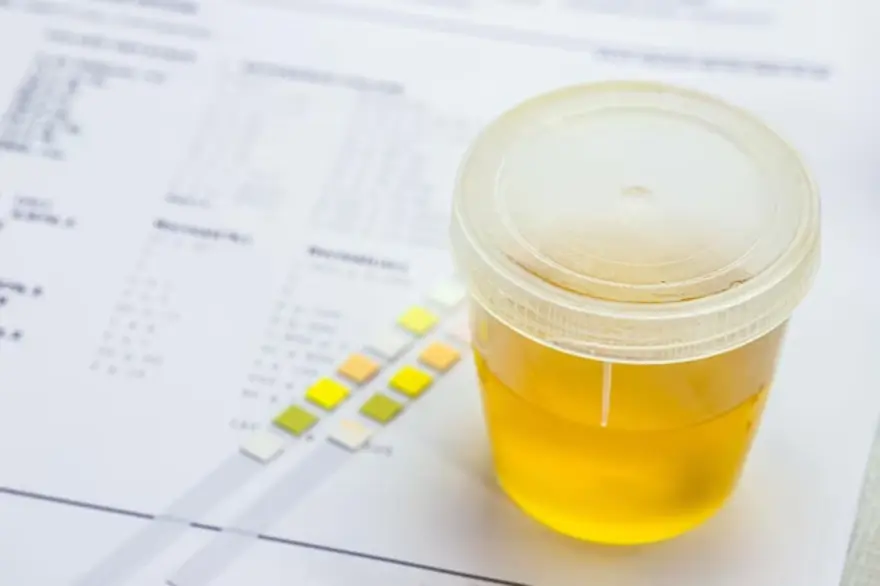Preventive Healthcare
Understanding Urinalysis Normal Range and Tests
78918 Views
0

A urinalysis is a test that examines the urine to look for signs of infection, disease, or other abnormalities. It is a simple and painless test that can be performed in a doctor's office or laboratory.
What is a urinalysis?
A urinalysis is a diagnostic test that examines the content of a person's urine. It is a commonly performed medical test that provides valuable information about the health of the urinary system and other organ systems in the body. Urinalysis involves the physical, chemical, and microscopic examination of urine.
Numerous diseases and conditions impact the body's ability to eliminate waste and toxic substances. Your skin, bladder, kidneys, lungs, and urinary tract are the organs that are affected by this. Urine quality, concentration, and appearance can all be impacted by issues with any of these.
What tests are included in urinalysis?
A urinalysis typically includes the following tests:
- Visual exam: The urine is examined for colour, clarity, and appearance.
- Chemical dipstick test: A chemical dipstick is placed in the urine to test for protein, glucose, ketones, blood, and pH.
- Microscopic exam: A small urine sample is placed under a microscope to look for cells, bacteria, and other particles.
Urine colour and appearance
The urinalysis's normal range of colour is pale yellow. However, the colour of urine can vary depending on many factors, including:
- Hydration level: Your urine will be pale yellow or almost clear if well-hydrated. If dehydrated, your urine will be darker yellow or even amber-coloured.
- Diet: Certain foods and drinks, such as beets, blackberries, and coffee, can change urine colour.
- Medications: Some medications, such as antibiotics and laxatives, can also change the colour of urine.
The appearance of urine can also vary depending on some factors, including:
- Clarity: Normal urine is clear. Cloudy urine can indicate infection, kidney stones, or other problems.
- Foaminess: Foam urine can be caused by excess protein in the urine or by using too much soap when washing the genitals.
- Blood: Blood in the urine can indicate infection, kidney stones, or other problems.
Urine chemical findings
Urine is a waste product that is produced by the kidneys. It contains water, urea, creatinine, and other chemicals. Urine chemical findings can provide valuable information about your health.
Protein in the urine
Protein is a substance that is essential for building and repairing tissues. When there is protein in the urine, it is a sign that the kidneys are not working correctly. Several conditions, including kidney disease, diabetes, and high blood pressure, can cause this.
Glucose in the urine
Glucose is a type of sugar that is the body's primary energy source. When there is glucose in the urine can be a sign of diabetes. Diabetes is when the body does not produce enough insulin, a hormone that helps the body's cells use glucose for energy.
Ketones in the urine
Ketones are chemicals the body produces when it breaks down fat for energy. When there are ketones in the urine, it can be a sign of diabetes or starvation.
Blood in the urine
Several conditions, including urinary tract infections, kidney stones, bladder cancer, and prostate cancer, can cause blood in the urine. It can also be caused by strenuous exercise or trauma.
Nitrites in the urine
Nitrites are chemicals that bacteria can produce. When there are nitrites in the urine, it can be a sign of a urinary tract infection.
Leukocyte esterase in the urine
Leukocyte esterase is an enzyme that is produced by white blood cells. White blood cells are part of the body's immune system and help to fight infection. When there is leukocyte esterase in the urine, it can be a sign of a urinary tract infection or kidney infection.
pH of the urine
The pH of the urine measures how acidic or alkaline the urine is. A high pH can be a sign of kidney stones or other problems. A low pH can be a sign of diabetic ketoacidosis or other issues.
Urine microscopic findings
Urine microscopic findings are the cells, crystals, and other particles seen in urine under a microscope. These findings can provide valuable information about your health.
Normal urine microscopic findings
Normal urine may contain a few white blood cells and epithelial cells. Epithelial cells are cells that line the urinary tract. A small number of white blood cells in the urine is normal. However, many white blood cells can be a sign of infection.
Abnormal urine microscopic findings
Abnormal urine microscopic findings can include:
- White blood cells (WBCs): Many WBCs in the urine can indicate infection, inflammation, or kidney damage.
- Red blood cells (RBCs): RBCs in the urine can indicate infection, kidney stones, bladder cancer, or prostate cancer.
- Casts: Casts are cylindrical structures formed in the kidneys when protein or other substances coagulate. Casts can be a sign of kidney damage.
- Crystals: Crystals can form in the urine when certain substances are concentrated. Different urinalysis types of crystals can indicate different medical conditions, such as kidney stones, gout, or diabetes.
- Bacteria: Bacteria in the urine can be a sign of infection.
- Yeast: Yeast in the urine can indicate a yeast infection.
- Parasites: Parasites in the urine can signify a parasitic infection.
Why do I need urinalysis?
There are many reasons why you need a urinalysis. Some of the most common causes include:
- To screen for kidney disease: A urinalysis can screen for kidney disease by looking for signs of kidney damage, such as protein or blood in the urine.
- To diagnose urinary tract infections (UTIs): A urinalysis can diagnose UTIs by looking for signs of infection, such as white blood cells or bacteria in the urine.
- To monitor the treatment of kidney disease or UTIs: A urinalysis can be used to monitor the treatment of kidney disease or UTIs by tracking changes in the urine.
- To screen for other medical conditions: A urinalysis can screen for other medical conditions, such as diabetes, liver disease, and pregnancy.
How common are urinalysis tests?
Urinalysis tests are very common. They are one of the most frequently performed medical tests in the world. Urinalysis tests can be done in a doctor's office, laboratory, or home using a home test kit.
What’s the difference between a urinalysis and a urine culture?
The main difference between a urinalysis and a urine culture is that a urinalysis is a general screening test, while a urine culture is a diagnostic test.
A urinalysis is a test that examines urine's physical and chemical properties. It is used to screen for various medical conditions, including kidney disease, urinary tract infections, and diabetes. Urinalysis tests can also be used to monitor the effectiveness of treatment for specific medical conditions.
A urine culture is a test that grows bacteria from a urine sample to identify the type of bacteria causing an infection. A urine culture is typically ordered when someone has a urinary tract infection.
How do I prepare for a urinalysis?
Before going for urinalysis, follow these steps:
Hydration: Drink water to ensure you can provide a urine sample.
Clean container: Use a clean, sterile container provided by the lab or your healthcare provider to collect urine.
Cleanliness: Wash your hands and genital area before collecting the urine sample to avoid contamination.
Midstream urine: Begin urinating into the toilet, then collect a sample midstream in the container. This helps avoid contamination from the first and last parts of urine.
Promptness: Deliver the sample promptly to the lab or your healthcare provider as soon as possible after collection. If there's a delay, refrigerate the sample.
It's essential to follow any specific instructions given by your healthcare provider for your urinalysis. They might ask you to avoid certain foods or medications before the test, so it's crucial to follow their guidance for accurate results.
What should I expect after urinalysis?
After a urinalysis tests, you can expect the following:
- If your typical urinalysis results are normal- Your doctor will likely tell you you do not need further testing or treatment. They may also give you general advice on staying healthy, such as drinking plenty of fluids and eating a healthy diet.
- If your typical urinalysis results are abnormal- Your doctor will likely order additional tests to determine the underlying cause of the abnormality. These tests may include blood, imaging, or other urine tests. Once the cause is known, your doctor can recommend appropriate treatment.
What can I expect during a urinalysis?
During a urinalysis, you will be asked to provide a urine sample in a sterile container. This sample will then be sent to a laboratory for analysis. The process involves several steps, including visual examination, chemical tests, and microscopic evaluation. Each step serves a unique purpose in assessing your urine's composition and identifying any abnormalities.
Collecting a clean catch urine sample if you have labia
To collect a clean catch urine sample with labia:
Wash Hands: Start by washing your hands thoroughly.
Clean the Area: Use a mild, fragrance-free soap to clean the labial area from front to back, ensuring cleanliness.
Separate Labia: Hold the labia apart with one hand to expose the urinary opening.
Void a Little: Start urinating into the toilet to clear the urethra, then stop.
Collect Sample: Position the sterile container to collect midstream urine without interrupting the flow.
Cap and Deliver: Securely cap the container and deliver it promptly to the lab or healthcare provider.
This method helps minimise external contaminants in the sample. Always follow any additional instructions provided by your healthcare provider for accurate collection. Consult the healthcare provider for guidance if you need more clarification.
Collecting a clean catch urine sample if you have a penis
To collect a clean catch urine sample with a penis:
Wash Hands: Begin by washing your hands thoroughly.
Clean the Area: Use a mild soap to cleanse the tip of the penis thoroughly.
Start Urinating: Let a small amount of urine pass into the toilet to clear the urethra.
Collect Sample: Place the sterile container to catch midstream urine without interrupting the flow.
Cap and Deliver: Securely cap the container and deliver it promptly to the lab or healthcare provider.
This method minimises external contaminants in the sample. Always follow any additional instructions given by your healthcare provider for accurate collection.
Collecting a urine sample with a catheter
When using a catheter to collect a urine sample:
Cleanliness: Wash hands and use sterile gloves.
Sterile Catheter: Ensure the catheter is sterile and not expired.
Insertion: Insert the catheter into the urethra according to your healthcare provider's instructions.
Collect Sample: Allow urine to flow through the catheter into a sterile container.
Cap and Label: Securely cap the container, label it with your details, and deliver it promptly to the lab or healthcare provider.
Following proper sterile techniques is crucial to prevent contamination.
What should I expect after urinalysis?
After a urinalysis, you can expect your healthcare provider to discuss the results with you. They'll explain what the test revealed about your urine, any abnormalities found, and any necessary next steps or treatments.
Are there any risks to urinalysis?
Yes, there are some risks to urinalysis, although they are very rare.
- Infection: There is a minor disease risk if a catheter is used to collect the urine sample.
- Discomfort: The catheter may cause some pain during insertion and removal.
- Allergic reaction: Some people may be allergic to the materials used in the urinalysis test strips.
- Inaccurate results: Urinalysis test results can be affected by several factors, including diet, medications, and exercise. This means that the typical urinalysis results may only be accurate in some cases.
When should I know the results of my urinalysis?
The results from a urinalysis are available within 24 to 48 hours, but the time can vary based on the lab's workload and the testing required.
How do I read my urine test results?
Understanding urinalysis test results involves analysing various parameters:
- Colour and Appearance: Normal urine is pale yellow. Cloudiness or unusual colours might indicate issues.
- Specific Gravity: Measures urine concentration. Low values may indicate hydration, while high values signify dehydration or kidney problems.
- pH Level: Indicates urine acidity. The urinalysis normal range is 4.6 to 8.0. Higher levels suggest kidney stones or urinary tract infections.
- Protein: High levels might suggest kidney issues.
- Glucose: Presence could indicate diabetes or high blood sugar.
- Ketones: Presence might signify fasting, low-carb diets, or diabetes.
- Blood: Detects blood cells in urine. Elevated levels might indicate infection, kidney stones, or other issues.
- Nitrites: Their presence might signal a bacterial infection.
- Leukocyte Esterase: High levels might suggest a urinary tract infection.
- Bilirubin and Urobilinogen: Elevated levels could indicate liver or bile duct issues.
- Microscopic Examination: Detects cells, crystals, or bacteria in urine that might signify infections or other conditions.
Your healthcare provider will interpret these results considering your medical history and symptoms. Abnormal findings might require further testing or treatment. Always consult your healthcare provider for proper interpretation and guidance regarding your urine test results.
Should I be concerned if I have an abnormal result on my urinalysis?
An abnormal result in a urinalysis doesn't always indicate a severe issue, but it warrants attention. Discussing abnormal findings with your healthcare provider to understand the cause is essential. Sometimes, abnormal results might stem from factors like diet, dehydration, or temporary conditions.
However, they could also signal underlying health problems such as infections, kidney issues, or metabolic disorders. Prompt discussion with your healthcare provider ensures proper evaluation, potential further testing if needed, and appropriate treatment for an underlying health concern.
When should I call my doctor?
Call your doctor if you notice significant changes in urine colour or consistency or have symptoms like persistent pain during urination, frequent urination, blood in urine, or unusual odours. Also, if you've had a recent urinalysis and have concerns about the results, it's wise to contact your doctor for guidance and clarification.
What do the results of a urinalysis mean?
The results of a urinalysis's normal range can provide valuable information about your overall health. The test can screen for various medical conditions, including kidney disease, urinary tract infections, and diabetes. It can also be used to monitor the effectiveness of treatment for specific medical conditions.
Here is a brief overview of what the most common urinalysis findings mean:
- Colour: The normal colour of urine is pale yellow. Darker urine can be a sign of dehydration or infection. Cloudy urine can be a sign of disease or other problems.
- Appearance: Normal urine is clear. Cloudy urine can indicate infection, kidney stones, or other problems.
- pH: The pH of urine measures how acidic or alkaline the urine is. A high pH can be a sign of kidney stones or other problems. A low pH can be a sign of diabetic ketoacidosis or other issues.
Conclusion
A urinalysis is an important and common test that can provide information about many areas of your health. If you want to get the urinalysis done then do check the services offered by us at Metropolis Lab. Our experienced technician can collect a sample from home, if you are not willing to step out. You can then easily collect your report online.













1701259759.webp)









 WhatsApp
WhatsApp